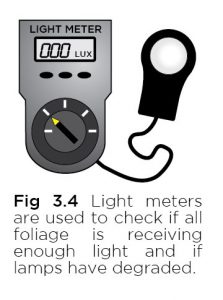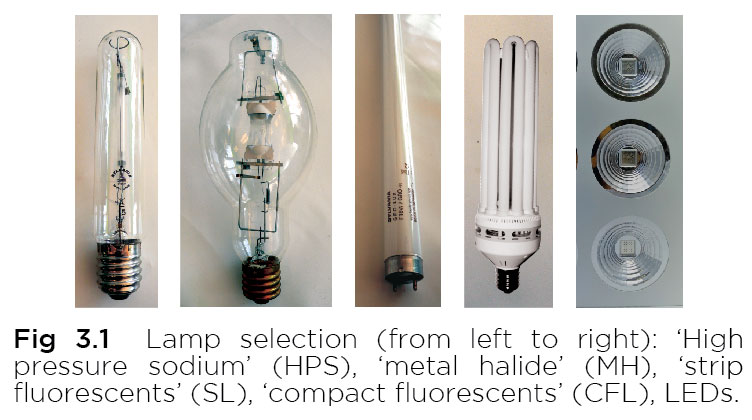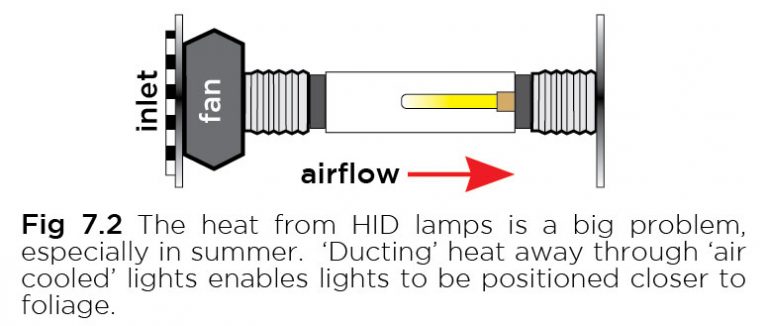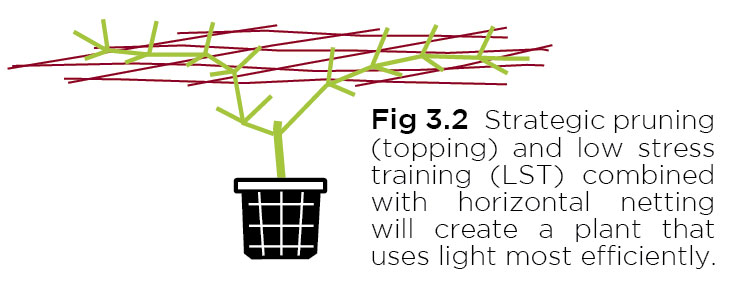
Growing plants indoors under grow lights is very different to outdoor growing. Pay particular attention to the lamp size and type, plant height and density, and the distance between the lamp and foliage.
The lamps size (wattage) and type (spectrum) is essential for ensuring plants receive adequate light. When using HID or fluorescent lamps, lux* meters are useful for checking if all foliage is receiving the correct amount of light . Ensure to check both high and low:
• Clones /seedlings: 5,000–7,000 lux. Use fluorescent.
• Vegetative growth: 15,000–50,000 lux. Use MH lamp.
• Flowering: 45,000–70,000 lux. Use HPS lamp.

*PAR meters are more accurate and can also be used to test LED lights, however they are very expensive.
Can be caused by foliage being too far from the lamp i.e. lamp is too high, or plants are too tall, or area of coverage is inadequate (see below). May also be due to shading from over-planting, inadequate plant shaping/ training, incorrect lamp size/type, or due to a faulty lamp or incompatible ballast. Insufficient light will produce sparse foliage, spindly branches and poor flowering

Too much light?
Can be caused by foliage being too far from the lamp i.e. lamp is too high, or plants are too tall, or area of coverage is inadequate (see below). May also be due to shading from over-planting, inadequate plant shaping/ training, incorrect lamp size/type, or due to a faulty lamp or incompatible ballast. Insufficient light will produce sparse foliage, spindly branches and poor flowering.
Area of coverage

The lamp’s wattage will largely determine the size of the ‘effective’ growing area – see Fig 3.3 and Table 3, “Area of coverage”. However, to unleash the lamp’s full potential, it is critical to also choose a lamp shade that provides maximum reflection efficiency and focuses the light evenly (without hot spots) and with the correct amount of spread i.e. not too wide or narrow. The use of reflective material on walls and other large surfaces helps ensure that light is not wasted through absorption.

Light intensity diminishes rapidly as distance from the lamp increases. Therefore, along with choosing the correct wattage, it is important to ensure the majority of foliage is positioned within the lamp’s “sweet-zone”. This is best achieved by training plants into a low, wide and flat canopy (Fig 3.2) – see section on Topping and LST (Fig 8.1).
Lamp height

To best utilize lamp output, position the lamp as close as possible to the top of plants without causing photo-respiration or burning of foliage (see Table 3 for “minimum gap” guidelines). Air cooled lights should be used because they enable lamps to be positioned closer to the foliage. These are particularly beneficial for 1,000W lamps (Fig 7.2). Ensure lamps are hung so that their height can be easily adjusted as the plants grow.
Plant density / shading
Shading becomes an issue when plants are positioned too close to one another. It is generally more productive to plant fewer plants, rather than more.
Andrew Taylor is an analytical chemist with additional qualifications in plant function and nutrition. He has over 25 years’ experience in product research and development, and commercial manufacturing. Visit their website at Floramax.com.
Related Articles & Free Email Newsletter
Curious About CBD? Here’s What it Can and Cannot Do for You
How to Diagnose and Correct Nutrient Deficiencies in Plants in Indoor Gardens


Comment here